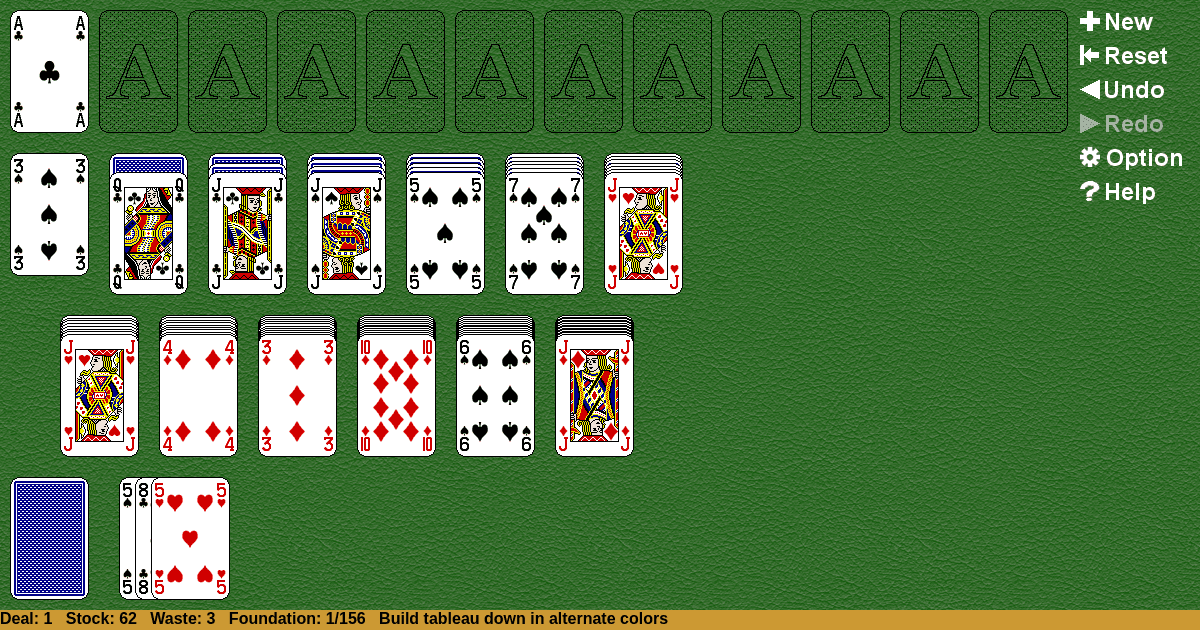Triple Klondike
Home |
How to play |
FAQ |
About
How to play Triple Klondike?
Game Objective:
The primary goal in Triple Klondike Solitaire is to move all cards from the tableau and stock to the twelve foundation piles, building each pile up in ascending order from Ace to King by suit.
Setup & Layout:
- Deck: Triple Klondike uses three standard 52-card decks shuffled together, totaling 156 cards.
- Tableau: Deal cards into 13 columns. The first column receives 1 card, the second receives 2 cards, and so on, up to the thirteenth column, which receives 13 cards. Only the top card of each column is dealt face-up; all cards beneath are face-down.
- Stock: The remaining cards after the tableau is dealt form the stock pile, placed face-down.
- Foundations: There are 12 foundation piles (three per suit), each to be built from Ace to King in ascending order and by suit.
- Key Play Areas:
- Tableau: The main play area with 13 columns.
- Foundations: The target piles where cards are built up by suit.
- Stock: The face-down pile from which new cards enter play.
- Waste: (If applicable) Cards drawn from the stock may be placed into a waste pile, with only the top card available for play.
Triple Klondike Solitaire Rules:
- Building on the Tableau: Cards are built downward in rank and must alternate in color (red-black-red, etc.). For example, a black 8 can be placed on a red 9.
- Moving Cards: You may move:
- A single card or a group of cards in proper descending, alternating-color sequence between tableau columns.
- Only the top card of each tableau pile is available for play unless a sequence is moved.
- When a face-down card is uncovered in the tableau, it is immediately turned face-up.
- Foundations: Each foundation pile starts with an Ace and is built upward in suit to King (A, 2, 3, …, K).
- Stock and Waste: Cards are drawn from the stock pile, typically one or three at a time depending on variant, and placed into a waste pile. Only the top card of the waste pile is available for play onto the tableau or foundations.
- Empty Tableau Columns: Only a King (or a sequence starting with a King) may be moved to fill an empty tableau column.
Gameplay:
- Turn Sequence:
- Move cards within the tableau by building down in alternating colors.
- Move cards to the foundations when possible, building up in suit from Ace to King.
- Draw cards from the stock pile when no moves are available on the tableau. If using a waste pile, only the top card is playable.
- When a face-down card is uncovered in the tableau, flip it face-up and continue play.
- Introducing New Cards:
- Draw from the stock pile to the waste pile, as per the variant's rules (usually one or three cards at a time). Play cards from the waste pile to the tableau or foundations as allowed.
- No More Moves:
- If no legal moves remain and the stock is empty (and no redeals are left, if applicable), the game ends.
Winning & Losing Conditions:
- Win Condition: The game is won when all 156 cards have been moved to the twelve foundation piles, with each pile containing a full Ace-to-King sequence of a single suit.
- Lose/Unwinnable Condition: The game is lost if no more legal moves are possible and the stock is depleted (and all allowed redeals, if any, are exhausted), leaving cards stranded in the tableau or waste.
Special Rules & Edge Cases:
- Filling Empty Tableau Columns: Only a King or a properly ordered sequence starting with a King may be moved into an empty tableau column.
- Multiple Decks: Since three decks are used, there will be three of each card in play. Each foundation pile must be built with cards of the same suit, but each suit will have three separate Ace-to-King piles.
- Redeals: Some versions allow the stock to be recycled (redealt) after it is exhausted, but the number of redeals may be limited or unlimited depending on the specific house rules or software implementation.
- Relaxed Variants: Some versions may allow all tableau cards to be face-up for easier play, but this is not standard.
- Moving Sequences: You may move an entire sequence of properly ordered, alternating-color cards as a group between tableau columns.
- Waste Pile Play: Only the top card of the waste pile is available for play at any time.
Note: The above rules are based on the most common implementations and official descriptions of Triple Klondike Solitaire. Always check your specific game's settings for any additional house rules or variations.

Solitaire Collection
About Triple Klondike
Rate (Triple Klondike)
4.7 / 5
1,916 votes



























































